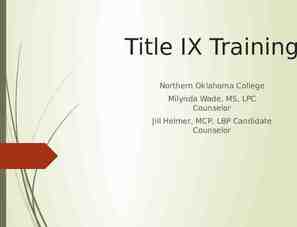Mac OS X Stephen Ayers David Der Nathan Henkel Dan Hodos William Hunt
13 Slides45.50 KB
Mac OS X Stephen Ayers David Der Nathan Henkel Dan Hodos William Hunt
Mac OS X Overview History & Background Processor Modes & Process States Memory Management Threads File Management Scheduling
Mac OS X 1990 History February 1994 – Apple announces the beginning of Copland August 1996 – Apple abandons Copland project December 1996 – Apple purchases NeXT for 430 million March 2001 – Apple releases Mac OS X September 2001 – Apple releases Mac OS 10,1 August 2002 – Apple releases Mac OS 10.2 October 2003 – Apple releases Mac OS 10.3 2004
Mac OS X Background Aqua Darwin – Open Source – Mach 3.0 – BSD core services Carbon Cocoa Java Quartz OpenGL QuickTime Darwin
Mac OS X Processor Modes & Privileged Instructions Supervisor Mode – allows execution of privileged instructions and access to privileged registers – Swapper (PID 0) – switches processes from main memory to secondary storage – PageDaemon (PID 2) – converts addresses to support the virtual memory subsystem User Mode - The processor mode that forbids execution of privileged instructions and access to privileged registers. Any attempt to do so will result in a privilege violation exception. – Init (PID 1) – spawns processes for remote terminals; changes run levels; can assume role of parent for orphaned process
Mac OS X Allowable Process States Process states for FreeBSD 4.4 SIDL: Process is partially created SRUN: Process is runnable SSLEEP: Process is awaiting event SSTOP: Process is stopped (by signal or parent process) SZOMB: Process is partially terminated (waiting for parent process to collect status)
Mac OS X Memory Management 5 Basic Mach Abstractions Task Thread Port Message Memory Object Basic VM Operations allocate a region of virtual memory on a page boundary, deallocate a region of virtual memory, set the protection status of a region of virtual memory, specify the inheritance of a region of virtual memory and create and manage a memory object that can then be mapped into the address space of another task.
Mac OS X Memory Management (cont.) Four basic memory management data structures are used in Mach: 1. the resident page table - a table used to keep track of information about machine independent pages 2. the address map - a doubly linked list of map entries, each of which describes a mapping from a range of addresses to a region of a memory object 3. the memory object - a unit of backing storage managed by the kernel or a user task and 4. the pmap - a machine dependent memory mapping data structure (i.e., a hardware defined physical address map).
Mac OS X File Management File related system calls Virtual File System (VFS) UFS HFS NFS UDP Disk Network The Darwin kernel implements a Virtual File System (VFS) that translates a filerelated system call into the matching call for the appropriate file system.
Mac OS X Threads Multiprocessing Thread Manager Services (Carbon) (Carbon) NSThread (Cocoa) java.lang.Thread Posix Threads Mach Threads Threads are scheduled to run preemptively or, with symmetric multiprocessing, concurrently. Threading models built on top of the kernel’s can, however, use various synchronization mechanisms to present cooperative threading behavior. The kernel environment of Mac OS X, specifically Mach, provides the fundamental thread support. Mach maintains the register state of its threads and schedules them preemptively in relation to one another. In the case of symmetric multiprocessing, the kernel can preemptively schedule threads concurrently, one on each processor. The client API for Mach threads is implemented in the System framework.
Mac OS X Scheduling Marriage of FreeBSD and Mach Uses a priority scheduling algorithm combined with a time quantum Priorities are stored in the PCB and range from 20 to 20 with higher values indicating lower level priority “Pzero” refers to a priority variable of 0 Reschedules every tenth of a second and recomputes priorities once every second
Mac OS X Scheduling No preemption in Mac OS X scheduling Task will relinquish CPU after time quantum or when it must wait for an I/O completion Process feedback – priorities change dynamically based on wait time and amount of time that the process has had the processor Feedback prevents starvation
Mac OS X Future Outlook “We are betting our future on Mac OS X.” –Steve Jobs Avie Tevanian, Chief Software Technology Officer at Apple, explained Mac OS X was the platform of the future: “We built Mac OS X hoping that it will last 15 to 20 years. I hope it does,” he joked. “I can’t go through this again.”


















